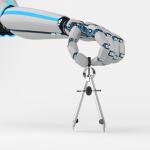Discover how FP&A professionals can lead digital transformation by integrating AI, Power BI, automation and continuous...

An Overview
FP&A leaders always look for new ways to improve financial management in today's fast-paced and often unpredictable world. Digital twin technology is a game-changing tool that makes a big difference in many fields. It first became popular in manufacturing and design, but its use in improving budgeting and forecasting is really revolutionary.
The 2025 FP&A Trends Survey shows that 59% of organisations say they make most of their decisions based on data, a 5% decline from 2024. While still a majority, this drop underlines the urgency for tools that strengthen data-driven decision-making in FP&A. This article explores how digital twin technology can help us better understand our complicated financial situations, using real-world examples to show how useful it can be.
What Is the Technology Behind Digital Twins?
Digital twin technology lets us make virtual copies of real-world things, processes, or systems we can change and study in real time. Think about having a model that shows how your business is doing right now and combines data from different sources, like IoT sensors, past metrics, and predictive analytics. This big-picture view can help us understand how an asset works and acts over time.
Digital Twin Technology's Benefits for Budgeting and Forecasting
Advanced Scenario Planning
Digital twins let us create a lot of different financial scenarios based on various assumptions about how the market works. This flexibility is very helpful when it comes to figuring out risks and chances before we set our budgets.
For example, think about a store using a digital twin of its sales data. They can try out different strategies, like changing their marketing budget or their inventory, to see what might work best by looking at how consumers might change their behaviour, which could be due to changes in the economy or trends.
Monitoring and Analytics in Real Time
One of the best things about digital twins is that they let you keep an eye on how well your finances are doing in real time. FP&A teams can quickly see how changes in operations or the market will affect the company's finances because data is always flowing. This is important for making timely changes to budgets and forecasts.
For example, in a manufacturing setting, using a digital twin to monitor how well things are being made can help finance teams figure out how much money they will lose immediately if productivity suddenly drops and change their forecasts accordingly.
Better Teamwork Between Departments
Sometimes it can be hard to work together in our roles, especially when trying to get different departments to work together. Digital twins give finance a place to work with operations, marketing, and supply chain teams to make sure that forecasts are based on what is really happening in the business.
For example, a technology company can use a shared digital twin to let finance, marketing, and product development work together. When marketing starts a new campaign, finance can use past data and predictive analytics to figure out how much money it might make. It helps them make better decisions about how to spend their money.
Better Predictive Analytics
Digital twins give us more data access, significantly improving our ability to predict things. Using Machine Learning algorithms, we can make financial predictions that aren't just educated guesses but are based on data-driven analysis.
A Real-World Example of Rolling Forecasts with Digital Twin Technology
Adding digital twin technology is a big deal for FP&A leaders who are open to rolling forecasts. Organisations can constantly update their forecasts based on real-time data by making a digital twin that focuses on important financial drivers like sales trends, market conditions, and operational capacities. 39% of businesses say it's hard to accurately predict their finances for over three months. They need to start using rolling forecasts to stay flexible and responsive to market conditions.
How to Use Digital Twin Technology in Budgeting and Forecasting
Set Goals and Needs: It's important to be clear about your goals before you start implementing. What parts of your budgeting and forecasting do you want to make better? Is it speed, accuracy, working together, or managing risk? The design and rollout of the digital twin will depend on what you want to achieve.
Combining Data: High-quality data is what makes a digital twin work. It is important to collect and combine historical and real-time data streams with relevant external data sources. Investing in strong data management systems will set the stage for successful integration.
Making Models: Create the digital twin model based on the goals you've set, making sure it accurately shows important financial processes. Working with teams from different departments will give you a full picture and get everyone on board.
Testing and Checking: Before using the digital twin for forecasting, it is essential to test and verify it thoroughly. Run the model through different scenarios to ensure it works well when the input changes and gives reliable outputs.
5. Always Getting Better: Think of the digital twin as a real thing. Update the model regularly with new data and insights, and use feedback from past budgeting and forecasting cycles to improve its ability to make predictions.
What the Future Holds for Digital Twin Technology in Finance
As digital twin technology gets better, a number of promising trends are likely to change how it is used for budgeting and forecasting:
Better Аrtificial Intelligence and Machine Learning Integration: We will probably see more advanced АI and Machine Learning features that will improve predictive analytics and decision-making.
Expansion into New Areas: Digital twins are currently most common in manufacturing and logistics, but they are likely to become more common in finance, healthcare, and retail as well. It will make budgeting and forecasting easier.
More Customisation: Аs technology improves, more companies will be able to get digital twin solutions that are made just for them and their needs.
Focus on Sustainability: Digital twins will help companies keep track of their environmental effects and predict how their sustainability efforts will affect their finances by aligning budgeting and forecasting with sustainability goals.
Соnclusion
FP&A leaders can use digital twin technology to help them understand the complexities of financial management. Digital twins can change the way we deal with uncertainty and drive strategic growth as we start to use better scenario planning, real-time analytics, and collaborative decision-making.
Getting Started: Tips that Work
Set Clear Goals: Before you start this journey, figure out exactly how digital twins will improve your budgeting and forecasting processes.
Invest in Good Data Management: Make sure you understand the importance of having clean, high-quality data from the start. Strong data governance will make sure that your digital twin works at its best.
Encourage Collaboration across Departments: Get input from people in different departments to ensure that forecasts align with what actually happens in the business. It will improve accuracy and accountability.
Embrace Continuous Learning: Use an iterative process to improve your digital twin regularly by using new data and helpful feedback from previous cycles. This proactive approach will make the model better at predicting things over time.
Using this new technology, we can make better financial decisions and help the market grow in a world that is becoming more dynamic.
Subscribe to
FP&A Trends Digest

We will regularly update you on the latest trends and developments in FP&A. Take the opportunity to have articles written by finance thought leaders delivered directly to your inbox; watch compelling webinars; connect with like-minded professionals; and become a part of our global community.







